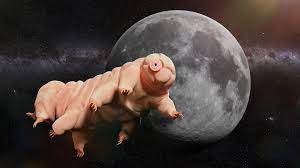Are Bears Taking Over the Moon?

August 23, 2022
From temperatures close to absolute zero, to the vacuum of space and radiation levels far beyond those lethal to humans, the tardigrade (less formally known as the water bear) is an extremophile. Extremophiles are organisms that thrive in extreme conditions, from intense temperatures to insane levels of acidity. So, could such organisms survive on the moon?
We ask this question for a somewhat concerning reason. On April 11th, 2019, an Israeli probe, deemed Beresheet, crash-landed on the moon after technical failures. This wash-machine sized probe carried a payload of over 30 million pages of digital data, including the entirety of the English Wikipedia, and a last-minute addition of ‘genetic samples’ and thousands upon thousands of tardigrades.
After the crash, the scientific community was concerned of cross-planetary contamination, as the extremophile tardigrades in theory could survive on the moon. So, is there a colony of water bears on the moon?
Sadly enough, new experiments can confirm that they most likely didn’t survive, (but we can still have hope). Being extremophiles, it wasn’t the cold, or the lack of oxygen, or low gravity that would have killed them; it would have been the force of the impact.
Researchers from the Queen Mary University of London tested the speed at which tardigrades can impact at and still survive. They did so by putting 2-4 tardigrades in a “tun” state (where the microorganism’s metabolism is slowed to 0.1% of its normal activity) inside of hollow nylon bullets. They then shot these tardigrade bullets from a two-stage light gas gun (basically a tank barrel that shoots super-pressurized hydrogen gas) that can reach firing velocities much greater than any traditional gun.
In doing so, they discovered that tardigrades can survive impacts of speeds up to 900 meters per second–2,013.24 miles per hour. The Beresheet is predicted to have impacted at around 130 miles per hour, meaning the tardigrades could have survived, if it wasn’t for the sheer shock pressure of the impact. Tardigrades have been recorded to survive up to 1.14 gigapascals of momentary shock pressure, which the impact would have immensely surpassed, meaning the lander itself killed the poor microorganisms.
In the end, there is, sadly enough, not a colony of tardigrades living on the moon, at least not from the Beresheet crash.




